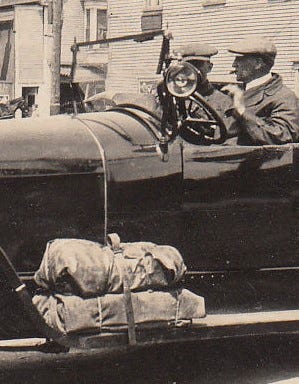Contest! Unstump Dave
I always try to make it clear in my car identification efforts that I am not infallible or unstumpable. I don’t really consider myself an expert, as I know countless people in the old car world — AACA judges and professional restorers — who easily put me to shame. My main goal is to have fun and spin a few yarns about readers’ old family photos, while giving the mystery car my best shot. That’s why I get a bit annoyed when anyone tries to treat DCIDS as the Let’s Stump Dave Contest.
But what’s more annoying is when I get a very earnest car ID request, with a decent resolution full shot of the vehicle, and I am left well and truly defeated by it. Even after hours of research and cross checking my reference resources.
Case in point: this wonderful submission from Mr. Don that he explains was found in a box of old family photos:
Despite my best efforts to the contrary, I’m afraid the make & model of this beauty remains a mystery (at least to me). Therefore I am going to turn to you, the DCIDS reader, to help alleviate my stress and ignorance over it: the first person who conclusively solves this ID in the comments (which will be open to the non-subscribing public) will receive a complementary one year subscription to DCIDS and my undying gratitude.
Now before you rush off to the comments section and type in “1877 Model T!” or “Rolls-Royce!” or “1929 Chitty Chitty Bang Bang!” I would like to point out I have literally spent 8-12 hours pursuing a solid ID on this car to no avail. So if you think you have the correct ID, please include a link to a photo that you believe proves your case. If I agree, consider yourself welcomed into the DCIDS Legion of Honor.
To get you started (and to reveal / articulate a bit about my car IDing process), I will deconstruct the photo and focus on some unique features of the car. Up front, it has 10 spoke wood wheels, 10 bolt hub, and 6 bolt rims. It has an arched, narrow flange grille that is painted rather than plated. No bumpers, and parallel leaf springs. Gently curved fenders that follow the tire radius. shallow bucket headlights. And most unusually, no louvers or vents on the hood. Possible suggestion (but not proof) of a steam engine.
Next, let’s go to the back. Aha! 12 spoke wheels in rear, which establishes this as a “10/12” wheel configuration. In addition, there is a hub cover and no visible hub bolts. Note also the smooth curvature from the running board into the rear fender, which is also very unusual.
Now let’s look at the cowl: a smooth high arch with no seams or creases, and the bottom of the windshield frame follows it. The two piece windshield tilts bottom and top independently, and their is a windshield spotlight.
Finally let’s zoom in on the mid-rear section. There is a second smooth cowl for the rear seat (this would be termed a dual cowl phaeton or touring). Note the rear door crease that is curved. There are no external door hinges or handles, and a small leather patch on the front door for the driver’s arm.
A successful ID will have all of these features. I’ve hunted about and eliminated the following close-but-no-cigar candidates:
1917-19 Chevrolet Series D touring
And that’s when I declared this one a cold case. So I hope you can unstump Yours Truly, and happy ID hunting!
Dave







I'm already a subscriber, but I found this clear picture after some of the earlier suggestions and it seems to be a 1916 Mormon '34 with some wooden wheels (Checks all the other boxes): https://www.flickr.com/photos/davydutchy/5560422405
My first instinct (because of the hood and radiator) was that it's a Marmon. And, as Jeffrey and maybe one or two others have already surmised, it does indeed appear to be a ca. 1916 Marmon Model 34. Can't find any pics of one with wooden wheels, but here's a pic of its near twin: https://www.ebay.com/itm/Vintage-RPPC-Real-Photo-Man-in-Fancy-Antique-Car-1916-Marmon-Model-34-touring-/303252424459?_ul=IN